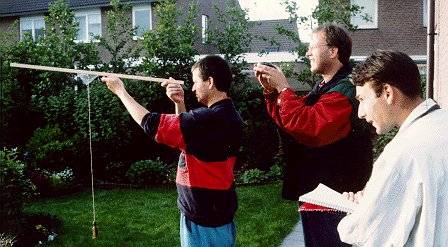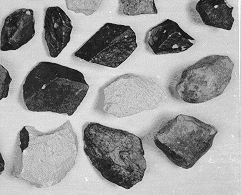The Dutch Meteor Society tries to track down new meteorites in order to make them available to the scientific community. Actually, this is one of the activities in which amateurs can have a large contribution. That such activities by amateurs can be very succesfull, is for example shown by our recovery and research on the Mbale meteorite.
There are many different ways in which DMS is active on this front. In short, we have: the continuously operating All Sky Network which photographically tries to capture nighttime meteorite falls by means of automatically operating camera's (we now have seven spread across the country) equiped with 'all sky' fish eye lenses; we track down and investigate newspaper stories about alledged falls and finds; we investigate 'falls' and 'finds' directly reported to DMS; we organize ad hoc measuring expeditions with daylight fireball apparitions; and we try to make people who, either by profession or hobby, spend a lot of time 'out in the fields' aware of the possibility of encountering a meteorite. For example, a number of Dutch amateur-archaeologists are now looking for meteorites too when surveying the fields for archaeological remains!
 |
Measuring altitudes and directions of apparition with an eyewitness of the
May 29, 1994, daylight fireball. Note that modest equipment is sufficient. From the established trajectory and end height, we are quite certain that this fireball did drop a meteorite, but unfortunately it dropped into sea... |
So far, we have been succesfull on two occasions. In his double role
of DMS member and co-worker of Leiden
Observatory, Peter Jenniskens (now
at NASA/Ames) hit
the jackpot with the Glanerbrug meteorite
fall of April 7,
1990.
And in 1992, DMS initiated the research on the large Mbale
meteorite fall of August 14, 1992 in Uganda (Africa) when we happened to have one of
our members (Jan Betlem) at the village of Mbale during the fall. In cooperation with
geologists of Uganda's Makarere University, DMS-members (most notably
Hans Betlem) directed and
conducted the larger part of the field work (collecting and mapping specimens
from this large strewnfield) and publication of the first research results. The
initial recovery work the first few days after the fall prevented many specimens,
including some of the largest ones, from disappearing forever.
Early 1993, one of our all sky camera's photographed an almost certain meteorite fall
at northern France, though the meteorite was unfortunately never recovered.
| 360 specimens collected by Hans Betlem
i.e. from the strewnfield of the Mbale meteorite. This is about one third of the total amount of specimens collected up till now. The largest mass weighs 27.4 kg (photograph Dutch National Museum of Natural History / DMS). See also our DMS publications page for an article in Meteoritics covering the Mbale meteorite fall in detail. A detailed figure showing a much larger number of fragments can be downloaded form the DMS FTP-site (300 kb!) |
 |
If you are not from the Netherlands, it is worth setting up your own program for meteorite recovery. It will take some time investment, but in return you get many suspense and hilarious stories...and maybe a real meteorite discovery!
When conducting such a program, you should have some skills however. You should be familiar with meteorites in order to be able to identify them. So go and visit collections at Natural History Museums, read a lot of books. Another thing which is important, is some basic knowledge of geology, more specifically knowledge of terrestrial rock forms. I have met 'investigators' who didn't even recognize easily recognizable porfiric stones! Some archaeological knowledge can be helpfull too, because many of the objects you will get for scrutiny will turn out to be human products, either 'modern' or 'prehistoric'. If you want to run a serious program, you should contact a professional meteoriticist too, because there will be cases that you are not 100% sure and need advice. Also, you will get objects of which you are sure that it is not a meteorite, but of which it is impossible to tell what it is...! These are the hard cases, since usualy the finder wants to know what it is 'if it is not a meteorite' and simply doesn't believe you if you can't tell him... On the other hand, these puzzling cases are the most enigmatic, and for me personally the most enjoyable.
Be prepared to invest time at the most strange times of the day. It can happen, that you receive a telephone call during a lazy rainy morning, and some minutes later you'll find yourselve in a car driving a distance of 200 miles at high speed towards a reported 'hole' in the roof of the house of the lighthouse- keeper at one of the islands and later on conducting a search around the house in the most bad and damned cold, windy and wet weather you ever experienced, not to mention the short voyage with the ferry through a rough sea (this is a true story: it happened on August 12, 1994. Unfortunately, there was no meteorite: only some slag material from soil hardening activities. The hole in the roof probably originated from the impact of a piece of ice falling from an airplane crossing the house... But it was fun, with all those press agencies and local radio reporters eagerly seeking your opinion). Or you are, on another originally lazy sunday, suddenly conducting a marathon voyage along eyewitnesses of a spectacular daylight fireball, to conclude from the measurements taken that the meteorite fell into sea...(again, a true story: the magnitude -21.5 North Sea daylight-fireball of May 29, 1994). And of course, there will be the 1123th specimen of iron furnace slag send to you by some stubborn finder who refuses to believe you if you tell him that it is not a meteorite but an iron furnace slag...
But it is fun! It provides you excitement, and good stories which you elaborately can tell in the pub or at conferences with your colleagues or friends. And most important: maybe, one day, it will provide you a genuine meteorite discovery...
 |